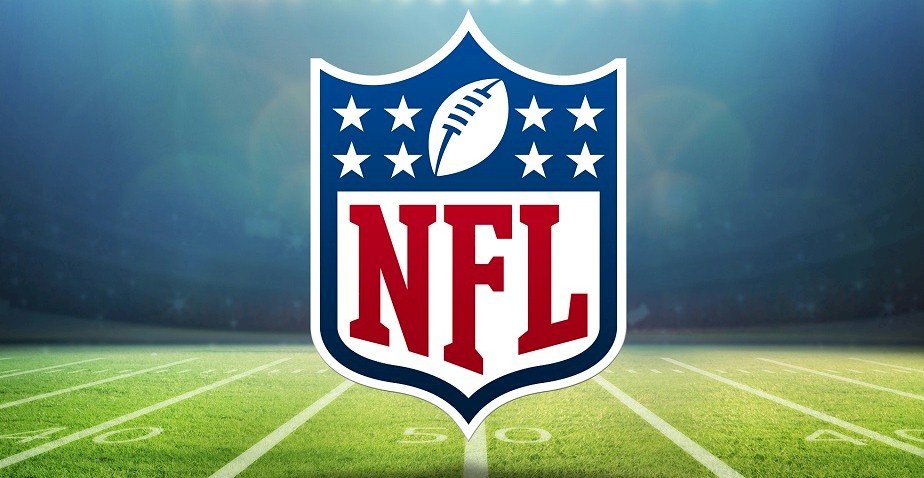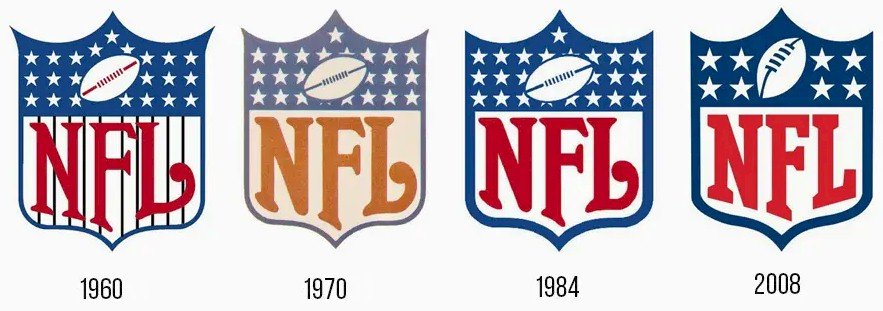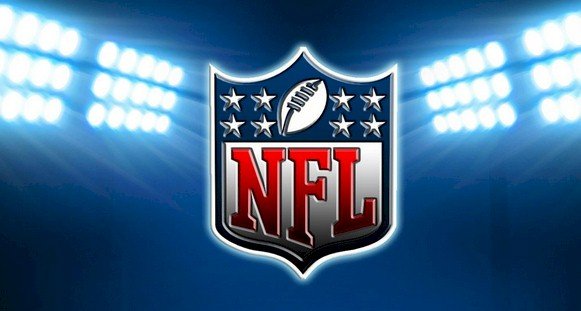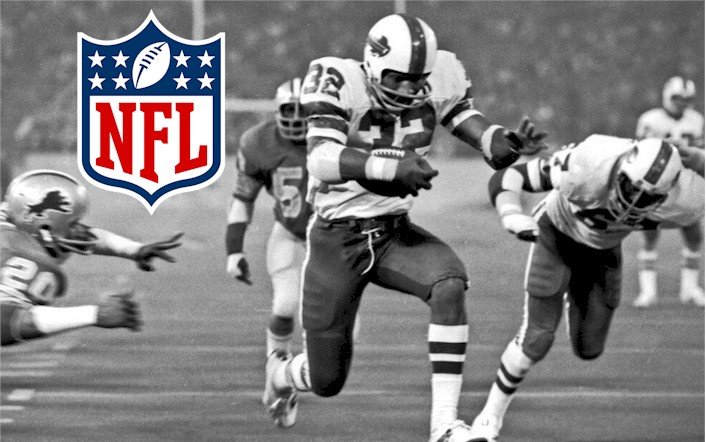The NFL logo has been the iconic symbol and shield ever since the league was formed in the 1920s. The shield, along with the inscription NFL and the stripes and stars of the American flag, has made the NFL logo one of the easiest to recognize. And while there have been a few alterations to the elements within the emblem, the overall concept has remained the same.
The National Football League (NFL) was officially established in 1920, with ten teams participating in the inaugural season. After decades of failed attempts, the NFL was the first to establish a national professional football presence successfully. Among the founding member teams, only two still play in the league—Chicago Bears and Arizona Cardinals. The league currently features 32 teams playing across the four major American regions.
 The NFL logo takes on the colors of the U.S. national flag—blue, red, and white. In the 1940s, however, the logo utilized pink for the stripes as well as the ball symbol. The stripes were altogether dropped in 1962, making for a less cluttered look.
The NFL logo takes on the colors of the U.S. national flag—blue, red, and white. In the 1940s, however, the logo utilized pink for the stripes as well as the ball symbol. The stripes were altogether dropped in 1962, making for a less cluttered look.
The current logotype features a clear custom serif font type. The letters are all uppercase, with the “F” stretched further below the other two letters.
NFL Logo Evolution
 The NFL logo has undergone quite a few changes over the decade in efforts to improve the symbol. Compared to the earlier decades, the current logo looks much sharper and cleaner, thanks to several revisions, including doing away with the stripes, reducing the number of stars, and updating the font type.
The NFL logo has undergone quite a few changes over the decade in efforts to improve the symbol. Compared to the earlier decades, the current logo looks much sharper and cleaner, thanks to several revisions, including doing away with the stripes, reducing the number of stars, and updating the font type.
The NFL Logo In the 1940s
The shield logo design itself dates back to 1921, around the time the American Professional Football Association (APFA) changed its name to the current NFL. The first major update came in the 1940s when the wordmark was moved down and the stars placed on the upper part. The stripes were made pink, while the letters took on a more refined look. This update became the basis for future logo iterations that eventually led to the current version, introduced in 2008.
1961 – 1982
A few refinements were introduced during this period, including changes in the shades of the colors. The biggest change was the removal of the red stripes behind “NFL.”
1983 – 2007
The version from1983 appears quite similar to its predecessor, at least at first glance. With a closer look, it becomes apparent that the outer border of the shield has been made thicker, while the oval ball position in the upper part has changed.
2008
From the beginning of the 2008 season, a new version of the emblem was introduced, featuring updates to each of the components. The number of stars was significantly reduced; there were only eight stars now, one for each of the eight divisions. The numerous stars from earlier versions were seen as not representing any particular meaning. The oval balls changed position, with their outlines also getting updated. The typeface also got updated to a straight serif, with the “L” in particular losing its curve.
NFL Logo Design Elements

NFL Logo Emblem: The NFL logo sticks out from logos of other football leagues with its display of sporty features that communicate excellence and glory. The shield, along with the capitalized NFL and the little oval ball, has become the defining elements of the emblem that’s become one of the most recognizable in the world.
NFL Logo Shape: The shield shape represents the league’s commitment to the highest standards of sporting entertainment. Besides being a marker of trust, it also communicates the founder’s proud association with the American identity, where the logo derived some of its inspiration from.
NFL Logo Color: The logo makes good use of the American flag’s colors—red, white, and blue. The shield symbol itself is blue, while the “NFL” logotype is in red against a white background. The small white stars, as well as the oval ball, blend nicely with the underlying blue.
NFL Logo Font: The NFL logo uses a custom serif type similar to the famous “College” font type. The current typeface, a straight serif, looks like an upgrade on the previous logotype that featured a distinctively curvy “L.”
The History of NFL
The NFL’s roots can be traced to as far back as 1892. This is the year when Allegheny Athletic Association paid William Heffelfinger $500 to represent them against Pittsburg Athletic club. With this move, William, a former Yale All-American guard, effectively became the first pro player of the game.
However, it would take close to three decades before the sport’s enthusiasts would establish a truly organized football league. This happened when the American Professional Football Association was formed in September of 1920. The league’s first season featured ten teams from four different states. In June of 1924, the league changed its name to National Football League.
The NF was initially conceptualized by Jim Thorpe, an American-India former Olympic athlete who was then a player-coach, and the owner of Rochester Jeffersons, Leo Lyons. In a match between Jim’s Canton Bulldogs and Rochester Jeffersons in 1917, Lyon’s team lost badly. Afterward, Lyon saw the possibility of forming a football league that could eventually rival the Major League Baseball in popularity. He suggested this to Thorpe, but their plans could not get underway due to the 1918 Spanish Flu outbreak.

World War I was also going on, which meant that many of the players were not available. Most sporting teams had to suspend operations and could only participate in local competitions. A majority of the players available were picked up by the New York teams that remained operational.
During the 1920s and the 1930s, the league became more and more organized, as membership increased and then stabilized. Starting in 1927, the NFL stopped teams from signing black players. This ruled stayed in effect until 1946, after World War II. Another change after the war was the change of the league President’s post, who now became the Commissioner, with more powers of execution.
As the league became more and more popular, the teams prospered, and the sport became more lucrative for young prospective players. By 1958, the championship game was already being billed “The Greatest Game Ever Played.” The NFL went on to become one of the country’s most popular sports league in the decades that followed.
A New Football League is Born
 In August 1920, the American Professional Football Conference was formally established, although it initially only featured teams from Ohio. The league then changed its name to American Professional Football Association a month later while also adding a few more teams from the neighboring states. The founding members drafted some rules surrounding player poaching and then elected Thorpe as President while he was still playing for the bulldogs.
In August 1920, the American Professional Football Conference was formally established, although it initially only featured teams from Ohio. The league then changed its name to American Professional Football Association a month later while also adding a few more teams from the neighboring states. The founding members drafted some rules surrounding player poaching and then elected Thorpe as President while he was still playing for the bulldogs.
Of the 11 founding teams, only four were able to complete the first season, which ended with the undefeated Akron Pros winning the championship. In 1921, league membership increased to 22 teams. However, for the majority of the 1920s, league membership remained somewhat unstable, and the organization was yet to become a significant sporting body in the country. The name National Football League (NFL) was formally adopted in June of 1924.
By the mid 1934s, most of the small-town teams had been replaced or merged into large big-city teams. The only small-town survivor was Green Bay Packers, which went on to partner with Milwaukee for support. For most of the early years of the league, many of the teams simply adopted the name of their city’s Major League Baseball team, such as “Pittsburgh Pirates” for Pittsburgh Steelers. Other teams that participated in the league at some point included the New York Yankees, Detroit Tigers, Washington Senators, and Cleveland Indians.
For a long time, college football had been the main attraction. The league changed after World War II when the league started to compete with college football events for attention. With changes to the game rules, such as the T formation, the game became speedier and higher-scoring.
The league also expanded its reach out of their main bases in the Midwest and the East Coast. The Cleveland Rams moved to Los Angeles in 1945 and became the first major sports franchise on the West Coast. Three new teams joined the NFL in 1950: The Baltimore Colts, the San Francisco 49ers, and the Cleveland Browns. This expanded the league to 13 teams. This is also the period when league games started getting broadcasted on national TV, establishing professional football as a major sport in the country.
NFL Dealing with Team Rivalry
A rival organization known as the American Football League was established in 1959. The AFL became a hugely successful endeavor, which forced a merger with the NFL. This would result in a more expansive league, as well as the annual Super Bowl, the most-watched sporting event in America.
The expansion continued up to the present 32 teams as demand for the sport increased. In the 1990s, thanks to a boon in television broadcasting rights, the league became one of the most profitable in America. The NFL is also the only major league to avoid work stoppage events that have disrupted other sporting leagues.
AFL–NFL Merger
By the mid-1960s, the competition for players had considerably increased, as the players’ wages also shot up. One of the most high-profile player transfers was Joe Namath, who signed for New York Jets for a record $427,000.

The two competing leagues, the NFL and AFL, went out of their way to acquire player signatures, including breaking the informal agreements between them at the time. As the AFL Commissioner launched a massive campaign to poach players away from the NFL, the NFL chiefs began discussing a solution to the unhealthy rivalry.
Eventually, a merger was agreed upon between the two associations, with the NFL as the name. Though the AFL ceased to exist, many of their innovations were adopted by the new NFL. This included things like player names on jerseys, having a game clock on-field, TV and gate revenue sharing, and less stringent game offensive rules. The AFL had also pioneered a recruitment strategy targeting small African-American colleges, which the new NFL adopted.
NFL Modern Era
Throughout the 1970s and 1980s, the NFL earned its place as the country’s top spectator sport and a significant part of the American culture. For most years, the Super Bowl ruled the roost as the best-rated televised program. It had also become an unofficial national holiday.

In 1970, Monday Night Football aired for the first time. The show scored very high ratings, thanks to its blend of sport and entertainment. And in the late 1970s, in a bid to attract the casual fan, new rule changes that made the game faster and more entertaining were introduced.
After the AFL-NFL merger, no major rivals came up until The World Football League was founded in 1974. The new challenger was off to a promising start as they even managed to poach some of the best talents away from the NFL. This led to the NFL introducing some rule changes, although the WFL would fold through the middle of their second season (1975) due to financial difficulties. A couple of teams from the WFL made unsuccessful attempts to get accepted into the NFL.
Later on, in the early 1980s, the formation of the United States Football League became the greatest threat to the NFL’s post-merger dominance. The USFL was well-oiled in the financial department thanks in part to a huge television broadcast contract. There were also quite a few big-name players on the roster. However, the USFL folded after just three years, having failed to turn in a profit.
Final Thoughts
The National Football League and the NFL Logo has become one of America’s most-followed sports leagues and brands in the world. The league was established way back in the 1920s but stayed far behind the baseball league for decades as it struggled to gain popularity.
In the 1950s, the league and sport’s fortunes changed when televisions started airing the games. And now, thanks to TV broadcast contracts, American football has become one of the richest leagues in the sporting world. It has also contributed to the American cultural scene with its live sporting events, as well as the iconic Super Bowl.
Along its journey to becoming a top sports league, the NFL faced a few major rivals but remained strong enough to fend them off, particularly after the merger with the AFL. Throughout the years, the NFL has maintained a consistent brand identity, with the shield logo evolving over the years to adapt to the times.







